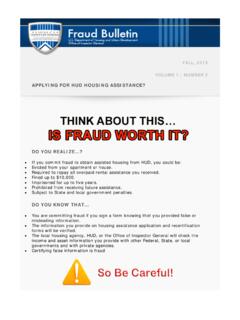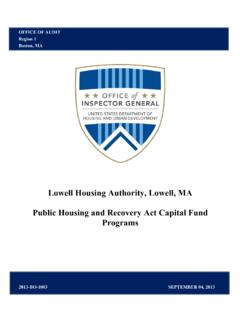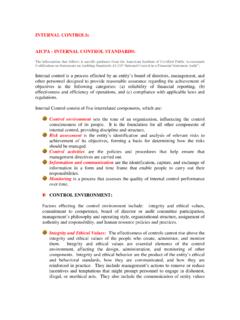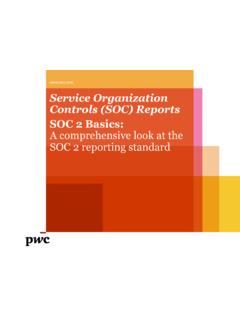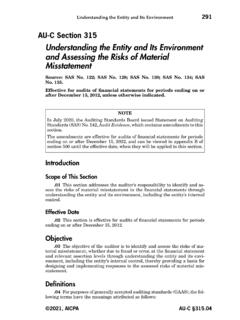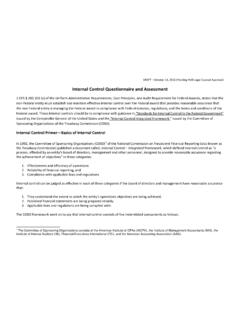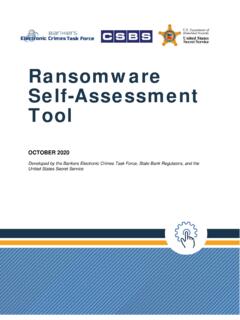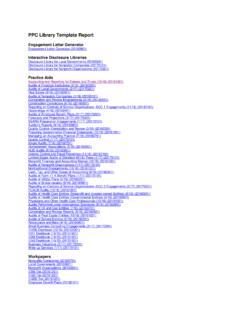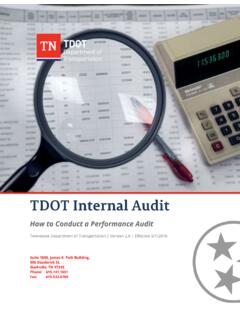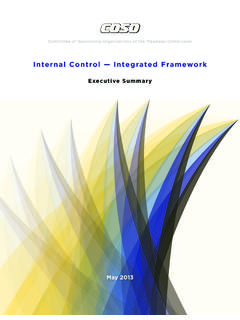Transcription of CHAPTER 7. FHA-APPROVED LENDERS AUDIT GUIDANCE 7-1
1 REV-2 Change 22 7- 1 11/2020 CHAPTER 7. FHA-APPROVED LENDERS AUDIT GUIDANCE 7- 1 Program Objective. The Department of Housing and Urban Development (HUD) insures loans and mortgages made by private and governmental, financial, and mortgage lending institutions to finance the purchase, refinance, or construction of single-family homes and multifamily projects. HUD approves such institutions for participation in the Federal Housing Administration (FHA) insurance programs for Title I property improvement and manufactured housing loans and for Title II single-family and multifamily mortgages.
2 After initial approval, institutions are required to recertify annually to maintain their FHA-APPROVED status. As defined in 24 CFR (Code of Federal Regulations) part 202, a lender or Title I lender is a financial institution that (a) holds a valid Title I contract of insurance and is approved by the HUD Secretary or (b) is under suspension or held a Title I contract that has been terminated but remains responsible for servicing or selling Title I loans that it holds and is authorized to file insurance claims on such loans. A mortgagee or Title II mortgagee is a mortgage lender that is approved to participate in the Title II programs.
3 HUD Handbook , FHA Single Family Housing Policy Handbook, is the consolidated source for all FHA policy. HUD Handbook covers Federal Housing Administration (FHA) approval and eligibility requirements for both Title I LENDERS and Title II mortgagees, as well as other FHA program participants. The term mortgagee is used throughout HUD Handbook for all types of FHA approval for both Title I LENDERS and Title II mortgagees, and the term mortgage is used for all products (both Title I loans and Title II mortgages), unless otherwise specified.
4 Throughout this guide, we use the terms lender and borrower to include mortgagee and mortgagor, respectively. Auditors must be aware that existing GUIDANCE and Federal regulations may continue to use both sets of terminology. For the Home Equity Conversion Mortgage (HECM) program, the definition of borrower does not include successors or assigns as it does in forward mortgages. 7- 2 Lender Approval Types. HUD has four types of LENDERS that are approved for participation. (Refer to 24 CFR through ) A. Supervised LENDERS .
5 Supervised LENDERS are financial institutions that are members of the Federal Reserve System (FRS) or institutions with accounts insured by the Federal Deposit Insurance Corporation (FDIC), the Office of the Comptroller of the Currency (OCC), or the National Credit Union Administration (NCUA). Supervised LENDERS may originate, underwrite, purchase, hold, service, or sell FHA-insured loans. 1. Small Supervised LENDERS . Small supervised LENDERS are members of FRS or regulated by FDIC, OCC, or NCUA, the consolidated assets of which do not meet REV-2 Change 22 7- 2 11/2020 the threshold required by those agencies for submitting audited financial statements (detailed at 12 CFR (a), (b)(2), and (c)).
6 2. Large Supervised LENDERS . Large supervised LENDERS are those LENDERS that are members of FRS or regulated by FDIC, OCC, or NCUA, the consolidated assets of which are equal to or greater than the prevailing threshold required by those agencies for submitting audited financial statements (detailed at 12 CFR (a), (b)(2), and (c)). B. Nonsupervised LENDERS . Nonsupervised LENDERS are lending institutions that have as their principal activity the lending or investing of funds in real estate mortgages, consumer installment notes, or similar advances of credit or the purchase of consumer installment contracts and are not approved as supervised, as described in paragraph A above, or as government LENDERS , as described in paragraph D below.
7 A nonsupervised lender may originate, purchase, hold, service, or sell all types of FHA-insured loans, including multifamily loans. C. Investing LENDERS . Investing LENDERS may purchase, hold, or sell FHA-insured loans but may not originate FHA-insured loans in their own name or submit applications for the insurance of mortgages. An investing lender may not service FHA-insured loans without prior approval of the HUD Secretary. Investing LENDERS are generally required to provide only audited financial statements and a computation of adjusted net worth. Those investing LENDERS that are authorized to service FHA-insured mortgages are also required to submit a report on internal controls and a report on compliance.
8 D. Government LENDERS . Government LENDERS are Federal, State, or municipal government agencies; a Federal Reserve bank; a Federal home loan bank; the Federal Home Loan Mortgage Corporation (Freddie Mac); or the Federal National Mortgage Association (Fannie Mae). A government lender may originate, purchase, service, or sell FHA-insured loans, including multifamily loans. No financial reporting is required. LENDERS with Title I authority are approved to process or service loans for property improvements and the purchase of manufactured housing.
9 LENDERS with Title II authority are approved to process or service loans for single-family homes and multifamily projects. A lender may be approved for both Title I and Title II programs. These institutions are approved on the basis of their financial capacity, experience, facilities, and other criteria as specified in HUD Handbook and subsequent mortgagee letters and Title I letters. REV-2 Change 22 7- 3 11/2020 7- 3 AUDIT and Reporting Requirements. The following chart is a summary of the financial reporting requirements for supervised and nonsupervised LENDERS .
10 A more detailed explanation of the financial reporting requirements is also provided below. Scenario Level of financial statements Audited consolidating schedules Financial data templates, including net worth schedule Net worth schedule (audited) Supervised LENDERS Stand-alone bank Bank N/A Bank Bank Bank 40% of consolidated entity; no guarantee by parent Consolidated Not required Consolidated Bank Bank <40% of consolidated entity; guarantee by parent Consolidated Not required Consolidated Bank Bank <40% of consolidated entity; no guarantee by parent Consolidated Required Bank Bank Multiple banks, each <40% of consolidated entity.

